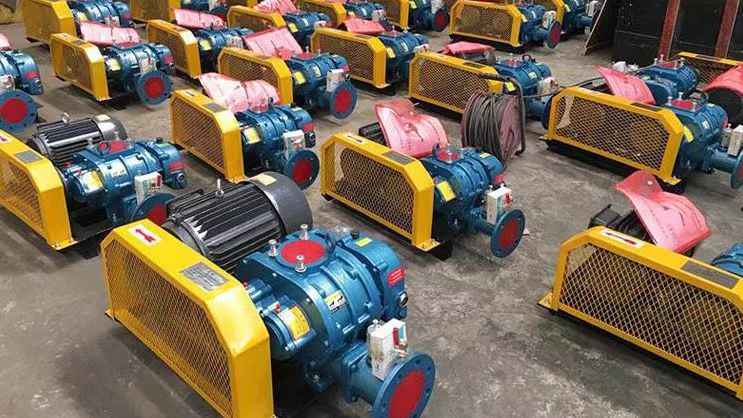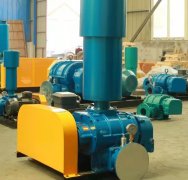Roots blower is a type of volumetric gas conveying equipment that uses two or more interlocked rotors to rotate inside the casing, forcibly pushing gas to achieve constant flow conveying. Its core function and typical applications are as follows:
---

**1、 Core functions**
1. * * Constant current conveying**
-The flow rate is directly proportional to the rotational speed and is almost unaffected by the outlet pressure (which is determined by the system resistance).
-Typical flow range: 0.5~300 m3/min, pressure range: 9.8~98 kPa (high pressure type can reach 147 kPa).
2. * * Oil free compression**
-There is no mechanical contact between rotors, and there is no lubricating oil pollution when transporting gas, making it suitable for high cleanliness requirements.
3. * * Sturdy structure**
-Simple and durable design, suitable for continuous heavy load operation (common in 24/7 working conditions).
---
**2、 Five core roles**
**1. Gas pressurized transportation**
-Industrial air supply:
-Provide combustion air (pressure 49~78.4 kPa) for boilers and blast furnaces.
-Pneumatic conveying of particles (such as cement and grain), with a pressure of 39.2~68.6 kPa.
-Vacuum adsorption:
-When used in reverse connection, it serves as a vacuum pump (with a negative pressure of up to -80 kPa) for suction cup handling and vacuum packaging.
**2. Sewage treatment aeration**
-Function: Inject air (pressure 39.2~58.8 kPa) into the aeration tank to promote microbial degradation of organic matter.
-Advantage: It is more adaptable to pressure fluctuations caused by water level changes than centrifugal fans.
**3. Gas circulation**
-Chemical process:
-Gas circulation in the reaction vessel (such as hydrogenation reaction), explosion-proof design (Ex d Ⅱ BT4).
-Transportation of flammable and explosive gases (requiring nitrogen sealing).
-Drying system:
-Hot air circulation (temperature resistance up to 200 ℃).
**4. Negative pressure generation**
-* * Medical/Laboratory * *:
-Dental suction and vacuum freeze-drying (10-100 Pa level requires cooperation with Roots vacuum pump).
-Industrial dust removal:
-Central dust collection system (negative pressure -20~-50 kPa).
**5. Replace traditional compressors**
-Low voltage scenario:
-30% more energy-efficient than piston engines (when pressure<98 kPa).
-50% lower cost than screw machines (for low flow requirements).
---
**3、 Industry application examples**
|* * Industry * * | * * Application Scenarios * * | * * Parameter Requirements * *|
|----------------|---------------------------|-----------------------------|
|* * Environmental protection * * | Sewage aeration, desulfurization and oxidation | Air volume of 20-100 m3/min, pressure of 49 kPa|
|Chemical industry * * | Gas recovery, reactor stirring | Explosion proof, 316L stainless steel material|
|* * Food * * | Vacuum packaging, oxygen supply for fermentation tanks | Oil free certification (FDA/NSF)|
|Metallurgy | Blast furnace blowing, electroplating tank aeration | Corrosion resistant coating, pressure 78.4 kPa|
|* * Electricity * * | Fly ash pneumatic conveying | Wear resistant impeller, air volume 50-200 m3/min|
---
**4、 Key parameters for selection**
1. * * Traffic * *: Increase the margin by 10-15 according to actual demand.
2. * * Pressure * *: System resistance+terminal equipment requirements (such as ≥ 39.2 kPa required for aeration water depth of 4 meters).
3. * * Power * *:` P (kW)=[Q (m3/min) × Δ P (kPa)]/(60 × η) ` (where η is taken as 0.6~0.75).
---
**5、 Comparison with similar devices**
|* * Features * * | * Roots blower * * | * * Centrifugal fan * * | * * Screw compressor * *|
|----------------|--------------------------|--------------------------|-----------------------|
|* * Flow stability * * | Constant (± 2) | Fluctuating with pressure | Stable under medium and high pressure|
|* * Energy Efficiency * * | Medium (50~65) | High (80~90) | High (75~85)|
|* * Maintenance cost * * | Low (no vulnerable parts) | Medium (requires regular calibration) | High (complex lubricating oil system)|
---
**Tip: Roots blower has significant advantages in low-pressure constant current scenarios, but overpressure should be avoided (valve set to 1.1 times working pressure). For high pressure (>98 kPa) or variable flow requirements, it is recommended to use screw machines or centrifuges.



